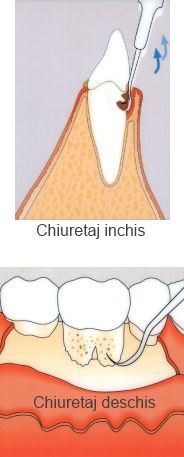
Subgingival debridement and curettage is a form of deep cleaning recommended in the treatment of infectious diseases of the periodontium. These procedures are used to treat infected areas by meticulously cleaning and removing tartar and bacteria from both the tooth surface and the subgingival area.
There are two types of subgingival curettage: closed and open. Closed-field curettage is performed without detaching the gum, while open-field curettage (flap surgery) is performed by incising the interdental papillae with a scalpel down to the alveolar bone, followed by removal of inflamed and necrotic epithelial tissue.
Subgingival curettage in open field
It is a surgical method that makes it possible to thoroughly clean the root surface and remove diseased tissue in good visibility. Bone grafts and proteins derived from the enamel matrix can be introduced into exposed periodontal pockets.
Subgingival open-field curettage is recommended for periodontal pockets of 4-6 mm and is not effective for greater depths.Studies have shown a reduction in the depth of periodontal pockets following curettage and a stabilization of periodontal disease for about 5 years.
The duration of a subgingival scaling session depends on the number of teeth to be treated and the amount of granulation tissue to be removed.
 RO
RO  EN
EN 